Research Foundation and Hotspot Analysis of Urban Road Ecology—A Bibliometric Study Based on CiteSpace
Abstract
1. Introduction
2. Methodology
2.1. Data Collection
2.2. Method Overview
2.3. Discussion on Analytical Methods
2.3.1. Collaboration Analysis
2.3.2. Co-Citation Analysis
2.3.3. Keyword Analysis
3. Results and Discussion
3.1. Collaborative Analysis
3.1.1. Author Collaboration Analysis
3.1.2. Institutional Cooperation Analysis
3.1.3. National Cooperation Analysis
3.2. Co-Citation Analysis
3.2.1. Citation Analysis of References
3.2.2. Analysis of Cited Journals
3.3. Keyword Analysis
3.3.1. Keyword Co-Occurrence Analysis
3.3.2. Keyword Clustering Analysis
3.3.3. Keyword Timeline Analysis Based on Cluster Results
3.3.4. Keyword Time Zone Map
3.3.5. Analysis of Citation Bursts
4. Conclusions and Future Expectancy
- (1)
- In terms of research methodology, it is necessary to break down professional barriers between the disciplines of road engineering, transportation, ecology, and urban landscape. For example, in question E of the 2024 American College Student Mathematical Modeling Competition, the stem of problems and context of research indicated an expectation for the development of comprehensive models related to engineering, finance, and ecology. In contrast, most of the literature in this study analyzes road ecosystems by employing an approach from a single subject area. It is also an important reason for the overall low relevance of the retrieved literature. Hence, this article argues that an interdisciplinary approach is significant for research in the field of urban road ecology.
- (2)
- From the perspective of theoretical concepts, a more targeted conceptual system is needed in the field of urban road ecology. The existing research phase in the field of road ecology has been defined as in a mature phase, in which specialized works have begun to establish a conceptual system for the discipline. However, this article argues that there are significant differences between urban road ecological research and the existing road ecological research, which can be manifested in the following three aspects. Firstly, disciplines such as urban landscape science, which studies urban planning and construction, are more relevant in the field of urban road ecology than the broader concept of road ecology. Secondly, the study of roads includes the study of urban roads and the study of highways, exhibiting significant differences in terms of function and structure, as evidenced by their distinct design specifications. Meanwhile, two different types of roads have different effects on the division of urban areas. Therefore, distinguishing between the concepts of urban road ecology and road ecology is necessary. Third, from an ecological perspective, urban ecosystems are significantly different from other ecosystems. Because urban ecosystems are characterized by a large number of industrial enterprises, higher population density, many sources of pollution, and severe traffic pollution, the analysis of urban ecosystems should be distinguished from the analysis of other ecosystems. Based on the above viewpoint, it is recommended to establish a conceptual system for urban ecosystems that is distinct from built concepts of road ecology.
- (3)
- In terms of practical applications, an important way to translate research results in urban road ecology is to provide a basis for the sustainable design and construction of urban roads. There are many directions for further research on the correlation between ecological evaluation and engineering practice in bibliometric research. For example, the segmentation effect in cities due to urban expressways may lead to ecological and environmental impacts such as a reduction in species diversity, destruction of biological habitats, and sound and light pollution in the surrounding environment. Moreover, these expressways may also have conflicting impacts on urban green space planning, road red lines, and urban architectural layout. Based on these interactions, this article argues that the research on how to plan urban roads to facilitate the coordinated development of ecological capacity, transportation volume, and urban land use planning can provide insights for optimizing road design specifications.
Funding
Conflicts of Interest
References
- Leonard, R.J.; Hochuli, D.F. Exhausting all avenues: Why impacts of air pollution should be part of road ecology. Front. Ecol. Environ. 2017, 15, 443–449. [Google Scholar] [CrossRef]
- Wang, B.; Yang, X.S.; Li, Z.C.; Geri, L. Discussion on road ecology research progress and development planning in China. In Proceedings of the 1st International Conference on Energy and Environmental Protection (ICEEP 2012), Hohhot, China, 23–24 June 2012; pp. 2770–2776. [Google Scholar]
- Chen, C.M. Visualizing and Exploring Scientific Literature with CiteSpace. In Proceedings of the 3rd ACM SIGIR Conference on Human Information Interaction and Retrieval (CHIIR), New Brunswick, NJ, USA, 11–15 March 2018; pp. 369–370. [Google Scholar]
- Yin, L.-H.; Wan, M.; Yao, Z.-Y. Research on Road Ecology and Consideration of Road Ecological Landscape Construction in China. Chin. Landsc. Archit. 2011, 27, 56–59. [Google Scholar]
- Forman, R.T.T.; Alexander, L.E. Roads and Their Major Ecological Effects. Annu. Rev. Ecol. Syst. 1998, 29, 207–231. [Google Scholar] [CrossRef]
- Jaarsma, C.F. Approaches for the planning of rural road networks according to sustainable land use planning. Landsc. Urban Plan. 1997, 39, 47–54. [Google Scholar] [CrossRef]
- Forman, R.T.T. Road Ecology: Science and Solutions; Island Press: Washington, DC, USA, 2003. [Google Scholar]
- D’Amico, M.; Ascenso, F.; Fabrizio, M.; Barrientos, R.; Gortazar, C. Twenty years of Road Ecology: A Topical Collection looking forward for new perspectives. Eur. J. Wildl. Res. 2018, 64, 2. [Google Scholar] [CrossRef]
- Yang, Z.C.; Zhao, W.T.; Liu, Y.; Chen, Y.Y. Using Genetic Optimization Algorithm to Intelligent System for Ecological Road Network Layout in Land Reclamation Area. Sens. Lett. 2013, 11, 1274–1281. [Google Scholar] [CrossRef]
- Fu, W.; Liu, S.L.; Dong, S.K. Landscape pattern changes under the disturbance of road networks. In Proceedings of the Biennial International Conference on Ecological Informatics and Ecosystem Conservation (ISEIS), Beijing, China, 27–29 August 2010; pp. 859–867. [Google Scholar]
- Yazici, M.A.; Kamga, C.; Ozbay, K. Highway Versus Urban Roads Analysis of Travel Time and Variability Patterns Based on Facility Type. Transp. Res. Rec. 2014, 2442, 53–61. [Google Scholar] [CrossRef]
- Zhang, Y.Z.; Hu, Y.F.; Zhuang, D.F. A highly integrated, expansible, and comprehensive analytical framework for urban ecological land: A case study in Guangzhou, China. J. Clean. Prod. 2020, 268, 12. [Google Scholar] [CrossRef]
- Zhang, M.; Du, H.Q.; Zhou, G.M.; Mao, F.J.; Li, X.J.; Zhou, L.; Zhu, D.E.; Xu, Y.X.; Huang, Z.H. Spatiotemporal Patterns and Driving Force of Urbanization and Its Impact on Urban Ecology. Remote Sens. 2022, 14, 1160. [Google Scholar] [CrossRef]
- Chaomei, C. CiteSpace II: Detecting and visualizing emerging trends and transient patterns in scientific literature. J. Am. Soc. Inf. Sci. Technol. 2006, 57, 359–377. [Google Scholar] [CrossRef]
- Xie, J.; Zhang, G.; Li, Y.; Yan, X.; Zang, L.; Liu, Q.; Chen, D.; Sui, M.; He, Y. A Bibliometric Analysis of Forest Gap Research during 1980–2021. Sustainability 2023, 15, 1994. [Google Scholar] [CrossRef]
- Estoque, R.C.; Murayama, Y.; Myint, S.W. Effects of landscape composition and pattern on land surface temperature: An urban heat island study in the megacities of Southeast Asia. Sci. Total Environ. 2017, 577, 349–359. [Google Scholar] [CrossRef] [PubMed]
- Krausmann, F.; Wiedenhofer, D.; Lauk, C.; Haas, W.; Tanikawa, H.; Fishman, T.; Miatto, A.; Schandl, H.; Haberl, H. Global socioeconomic material stocks rise 23-fold over the 20th century and require half of annual resource use. Proc. Natl. Acad. Sci. USA 2017, 114, 1880–1885. [Google Scholar] [CrossRef] [PubMed]
- Bradfer-Lawrence, T.; Gardner, N.; Bunnefeld, L.; Bunnefeld, N.; Willis, S.G.; Dent, D.H. Guidelines for the use of acoustic indices in environmental research. Methods Ecol. Evol. 2019, 10, 1796–1807. [Google Scholar] [CrossRef]
- Barber, J.R.; Burdett, C.L.; Reed, S.E.; Warner, K.A.; Formichella, C.; Crooks, K.R.; Theobald, D.M.; Fristrup, K.M. Anthropogenic noise exposure in protected natural areas: Estimating the scale of ecological consequences. Landsc. Ecol. 2011, 26, 1281–1295. [Google Scholar] [CrossRef]
- Kleemann, F.; Lederer, J.; Rechberger, H.; Fellner, J. GIS-based Analysis of Vienna’s Material Stock in Buildings. J. Ind. Ecol. 2017, 21, 368–380. [Google Scholar] [CrossRef]
- Liu, S.L.; Cui, B.S.; Dong, S.K.; Yang, Z.F.; Yang, M.; Holt, K. Evaluating the influence of road networks on landscape and regional ecological risk—A case study in Lancang River Valley of Southwest China. Ecol. Eng. 2008, 34, 91–99. [Google Scholar] [CrossRef]
- Lanau, M.; Liu, G.; Kral, U.; Wiedenhofer, D.; Keijzer, E.; Yu, C.; Ehlert, C. Taking Stock of Built Environment Stock Studies: Progress and Prospects. Environ. Sci. Technol. 2019, 53, 8499–8515. [Google Scholar] [CrossRef] [PubMed]
- Laurance, W.F.; Clements, G.R.; Sloan, S.; O’Connell, C.S.; Mueller, N.D.; Goosem, M.; Venter, O.; Edwards, D.P.; Phalan, B.; Balmford, A.; et al. A global strategy for road building. Nature 2014, 513, 229–232. [Google Scholar] [CrossRef]
- Chen, C.M.; Song, M. Visualizing a field of research: A methodology of systematic scientometric reviews. PLoS ONE 2019, 14, 25. [Google Scholar] [CrossRef]
- Bruce, M.J.; Bryant, D.B.; Kohout, M.; Macak, P.V.; Batpurev, K.; Sinclair, S.J. Southern brown bandicoots, Isoodon obesulus obesulus, occupy the margins of artificial waterways, in preference to bushland remnants or roadside vegetation. Wildl. Res. 2023, 50, 68–75. [Google Scholar] [CrossRef]
- Dall’Ara, E.; Maino, E.; Gatta, G.; Torreggiani, D.; Tassinari, P. Green Mobility Infrastructures. A landscape approach for roundabouts’ gardens applied to an Italian case study. Urban For. Urban Green. 2019, 37, 109–125. [Google Scholar] [CrossRef]
- Fröhlich, A.; Ciach, M. Noise shapes the distribution pattern of an acoustic predator. Curr. Zool. 2018, 64, 575–583. [Google Scholar] [CrossRef] [PubMed]
- Johansson, V.; Koffman, A.; Hedblom, M.; Deboni, G.; Andersson, P. Estimates of accessible food resources for pollinators in urban landscapes should take landscape friction into account. Ecosphere 2018, 9, 11. [Google Scholar] [CrossRef]
- Jarasuniene, A.; Bazaras, D. The implementation of green logistics in road transportation. Balt. J. Road Bridge Eng. 2023, 18, 185–207. [Google Scholar] [CrossRef]
- Ballantyne, M.; Pickering, C.M. The impacts of trail infrastructure on vegetation and soils: Current literature and future directions. J. Environ. Manag. 2015, 164, 53–64. [Google Scholar] [CrossRef] [PubMed]
- Li, Z.Y.; Liang, Y.M.; Zhou, J.H.; Sun, X. Impacts of de-icing salt pollution on urban road greenspace: A case study of Beijing. Front. Environ. Sci. Eng. 2014, 8, 747–756. [Google Scholar] [CrossRef]
- Lin, Y.Y.; Hu, X.S.; Zheng, X.X.; Hou, X.Y.; Zhang, Z.X.; Zhou, X.N.; Qiu, R.Z.; Lin, J.G. Spatial variations in the relationships between road network and landscape ecological risks in the highest forest coverage region of China. Ecol. Indic. 2019, 96, 392–403. [Google Scholar] [CrossRef]
- Kattel, G.R.; Elkadi, H.; Meikle, H. Developing a complementary framework for urban ecology. Urban For. Urban Green. 2013, 12, 498–508. [Google Scholar] [CrossRef]
- He, J.H.; Hao, Z.Z.; Li, L.; Ye, T.Y.; Sun, B.; Wu, R.C.; Pei, N.C. Sniff the urban park: Unveiling odor features and landscape effect on smellscape in Guangzhou, China. Urban For. Urban Green. 2022, 78, 10. [Google Scholar] [CrossRef]
- Izuddin, M.; Webb, E.L. The influence of tree architecture, forest remnants, and dispersal syndrome on roadside epiphyte diversity in a highly urbanized tropical environment. Biodivers. Conserv. 2015, 24, 2063–2077. [Google Scholar] [CrossRef]
- Wemple, B.C.; Browning, T.; Ziegler, A.D.; Celi, J.; Chun, K.P.; Jaramillo, F.; Leite, N.K.; Ramchunder, S.J.; Negishi, J.N.; Palomeque, X.; et al. Ecohydrological disturbances associated with roads: Current knowledge, research needs, and management concerns with reference to the tropics. Ecohydrology 2018, 11, 23. [Google Scholar] [CrossRef]
- Xu, Z.; Zhang, J.J.; Li, C.; Li, Z.Y.; Rao, Y.H.; Lu, T.Y. A Road to Sustainable Development of Chinese Cities: A Perception of Improving Urban Management Efficiency Based on Two-Level Production Factors. Sustainability 2017, 9, 2212. [Google Scholar] [CrossRef]
- Cordero, R.L.; Torchelsen, F.P.; Overbeck, G.E.; Anand, M. Analyzing the landscape characteristics promoting the establishment and spread of gorse (Ulex europaeus) along roadsides. Ecosphere 2016, 7, 14. [Google Scholar] [CrossRef]
- Freudenberger, L.; Hobson, P.R.; Rupic, S.; Pe’er, G.; Schluck, M.; Sauermann, J.; Kreft, S.; Selva, N.; Ibisch, P.L. Spatial road disturbance index (SPROADI) for conservation planning: A novel landscape index, demonstrated for the State of Brandenburg, Germany. Landsc. Ecol. 2013, 28, 1353–1369. [Google Scholar] [CrossRef]
- Brown, C.L.; Reed, S.E.; Dietz, M.S.; Fristrup, K.M. Detection and Classification of Motor Vehicle Noise in a Forested Landscape. Environ. Manag. 2013, 52, 1262–1270. [Google Scholar] [CrossRef] [PubMed]
- Quinn, J.E.; Schindler, A.R.; Blake, L.; Schaffer, S.K.; Hyland, E. Loss of winter wonderland: Proximity to different road types has variable effects on winter soundscapes. Landsc. Ecol. 2022, 37, 381–391. [Google Scholar] [CrossRef]
- André, M.; Garrot, B.; Roynard, Y.; Vidon, R.; Tassel, P.; Perret, P. Operating conditions of buses in use in the Ile-de-France region of France for the evaluation of pollutant emissions. Atmos. Environ. 2005, 39, 2411–2420. [Google Scholar] [CrossRef]
- Cui, J.; Jiang, C.L. Building highway landscapes: Innovative directions for urban wastewater treatment in the face of new challenges in China. In Proceedings of the International Conference on Green Buildings and Sustainable Cities (GBSC), Bologna, Italy, 15–16 September 2011; pp. 617–624. [Google Scholar]
- Grossegger, D. Material flow analysis study of asphalt in an Austrian municipality. J. Ind. Ecol. 2022, 26, 996–1009. [Google Scholar] [CrossRef]
- Hammer, R.B.; Stewart, S.I.; Winkler, R.L.; Radeloff, V.C.; Voss, P.R. Characterizing dynamic spatial and temporal residential density patterns from 1940-1990 across the North Central United States. Landsc. Urban Plan. 2004, 69, 183–199. [Google Scholar] [CrossRef]
- Akmal, F.; Khan, S.U.; Luqman, M.; Ahmad, S.R. Urban Sprawl Susceptibility Analysis of Sialkot City by Using Multicriteria Evaluation and Analytical Hierarchy Process. J. Urban Plan. Dev. 2022, 148, 11. [Google Scholar] [CrossRef]
- Wang, P.C.; Tang, Y.; Liao, Z.F.; Yan, Y.; Dai, L.; Liu, S.; Jiang, T.P. Road-Side Individual Tree Segmentation from Urban MLS Point Clouds Using Metric Learning. Remote Sens. 2023, 15, 1992. [Google Scholar] [CrossRef]
- Liu, X.L.; Wang, Y.; Li, Y.; Wu, J.S. Quantifying the Spatio-Temporal Process of Township Urbanization: A Large-Scale Data-Driven Approach. ISPRS Int. J. Geo-Inf. 2019, 8, 389. [Google Scholar] [CrossRef]
- Du, S.; Murray, R.L. Road salt pollution alters sex ratios in emerging mosquito populations. Environ. Pollut. 2023, 334, 9. [Google Scholar] [CrossRef]
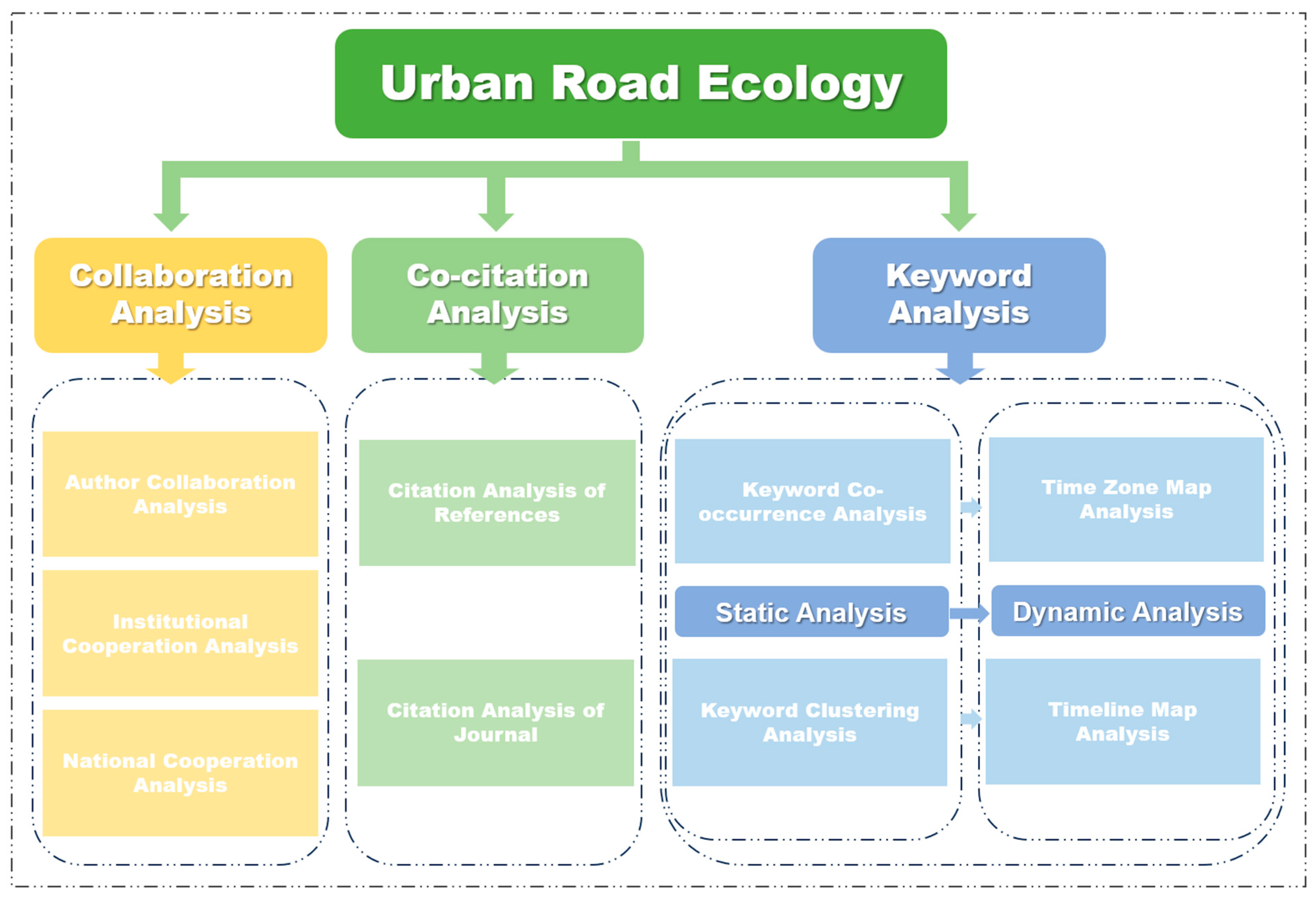
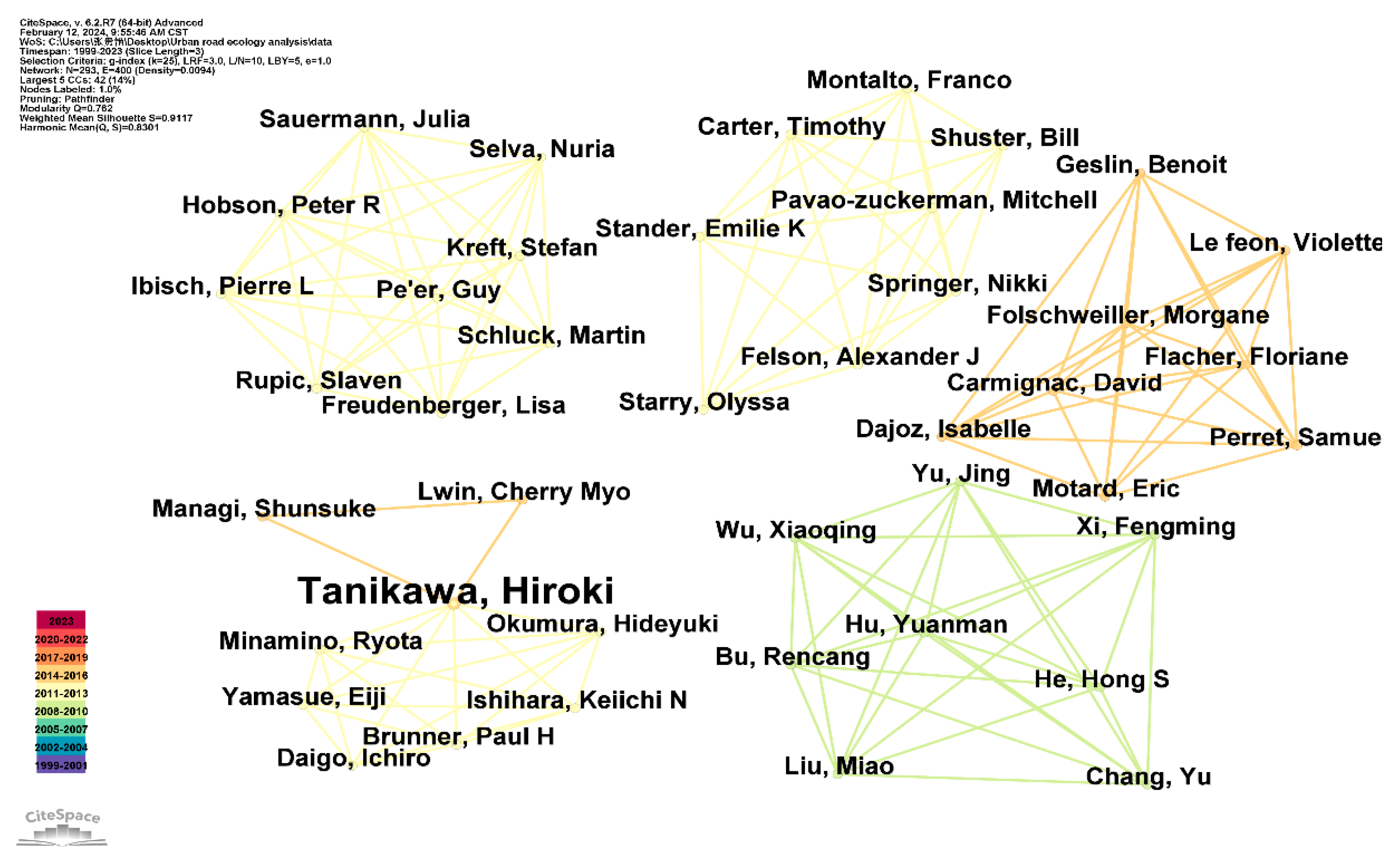
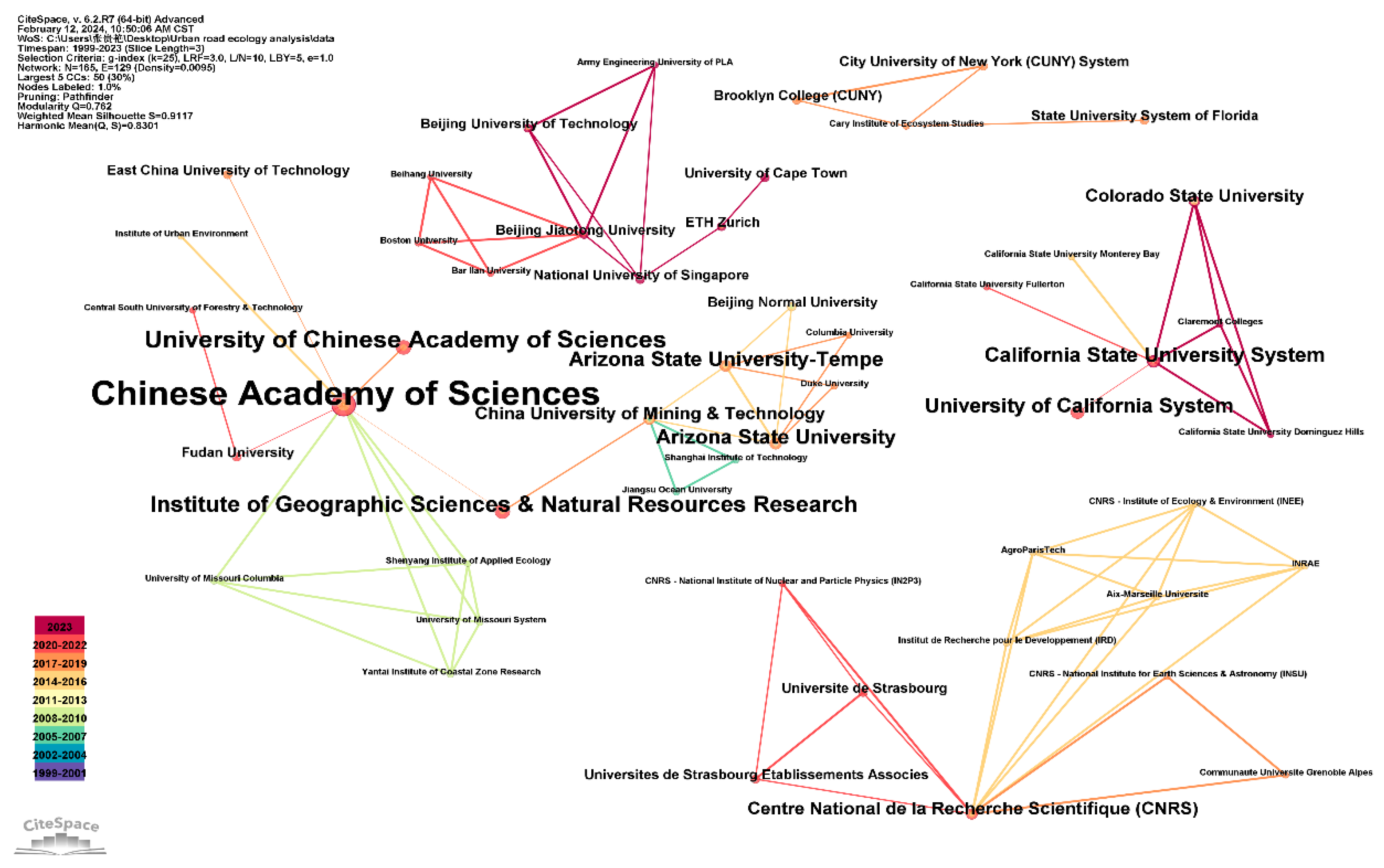
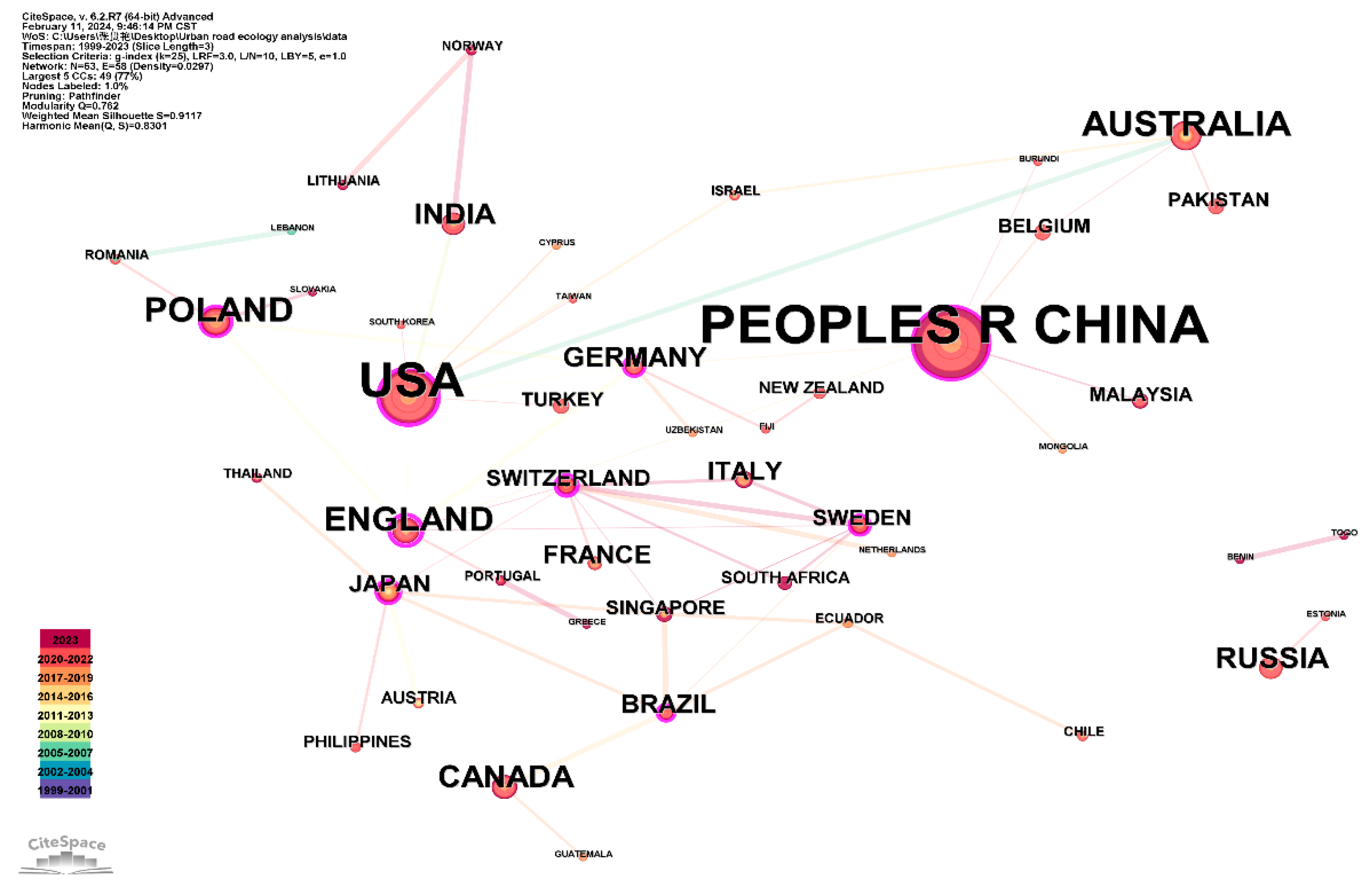


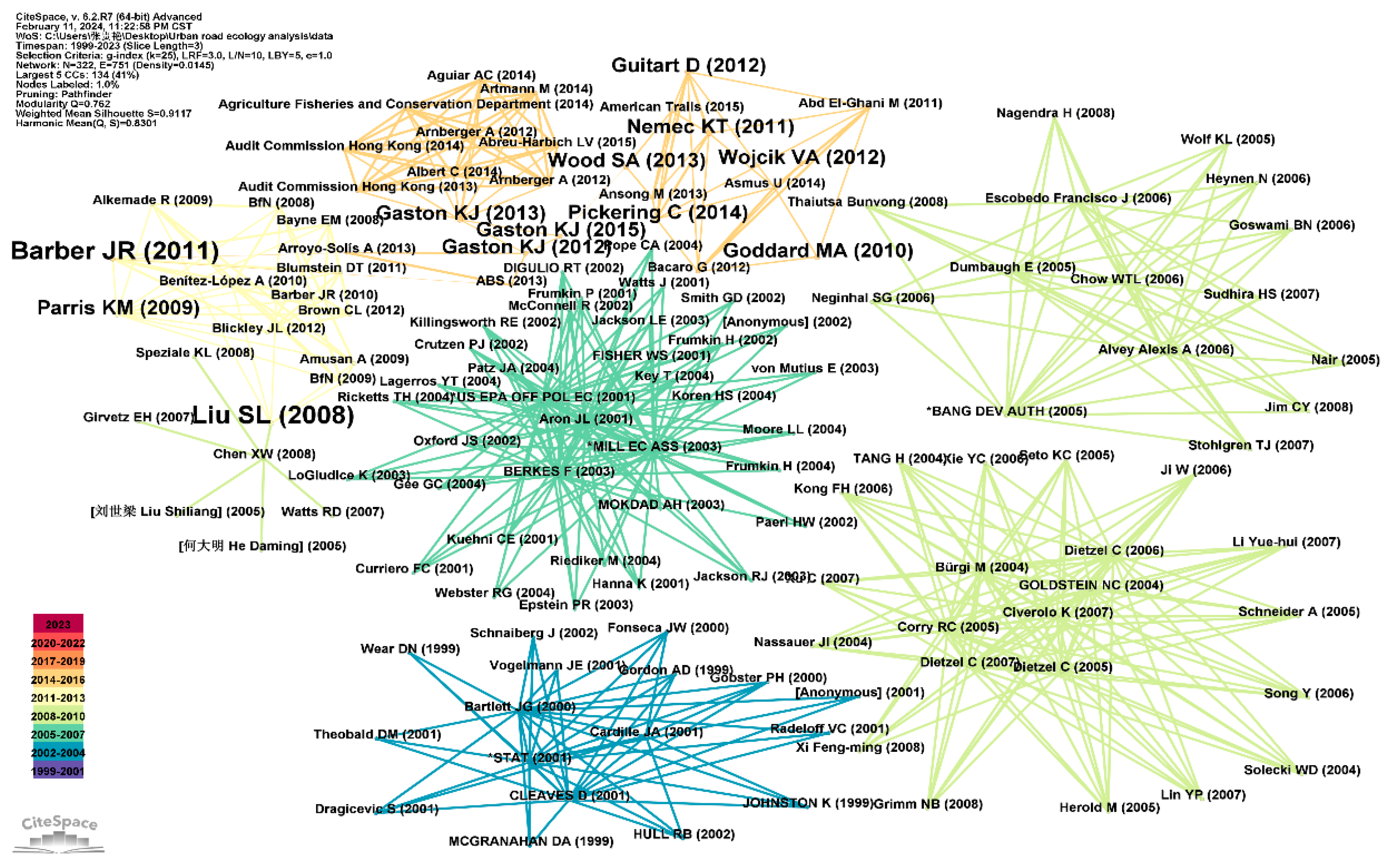

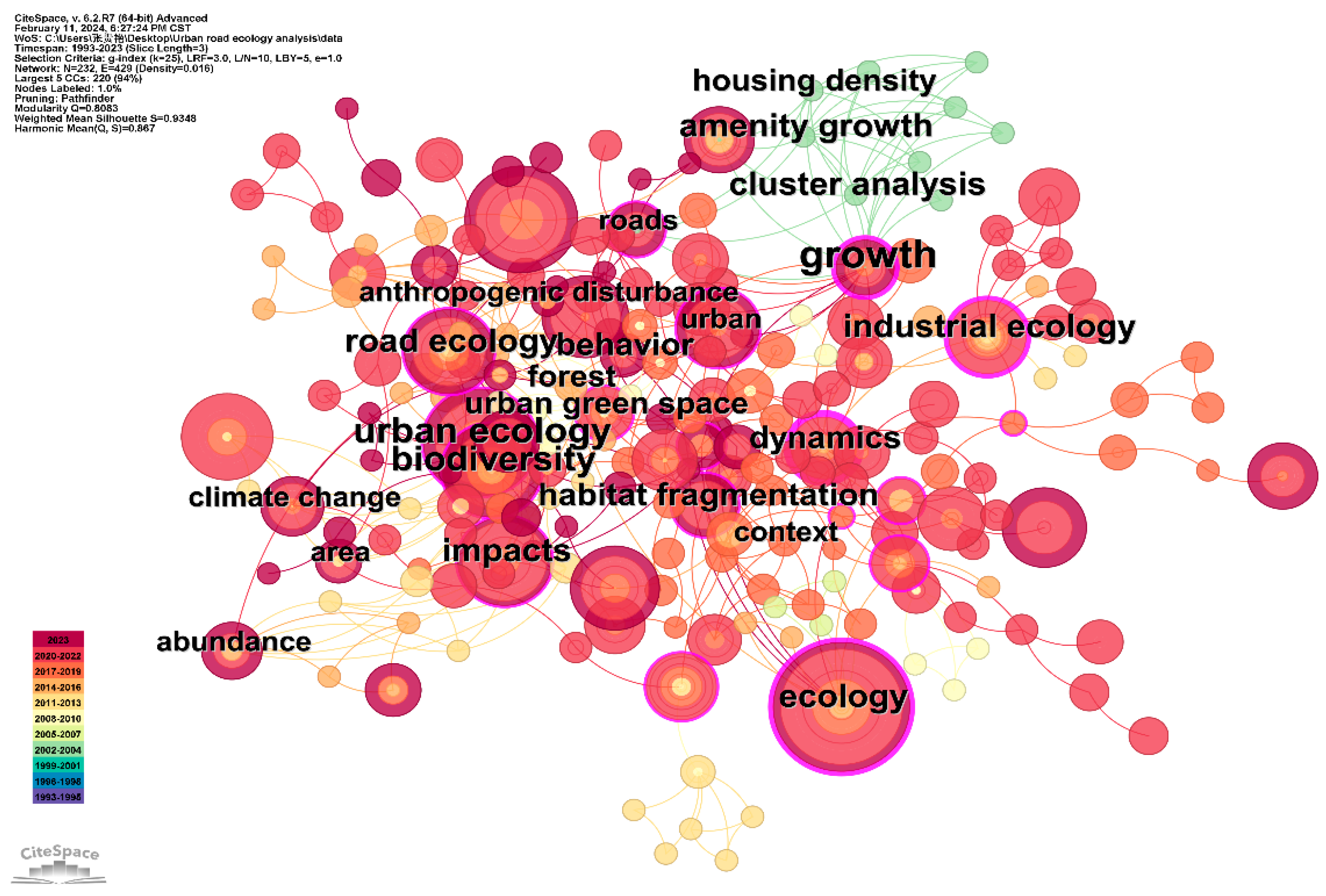

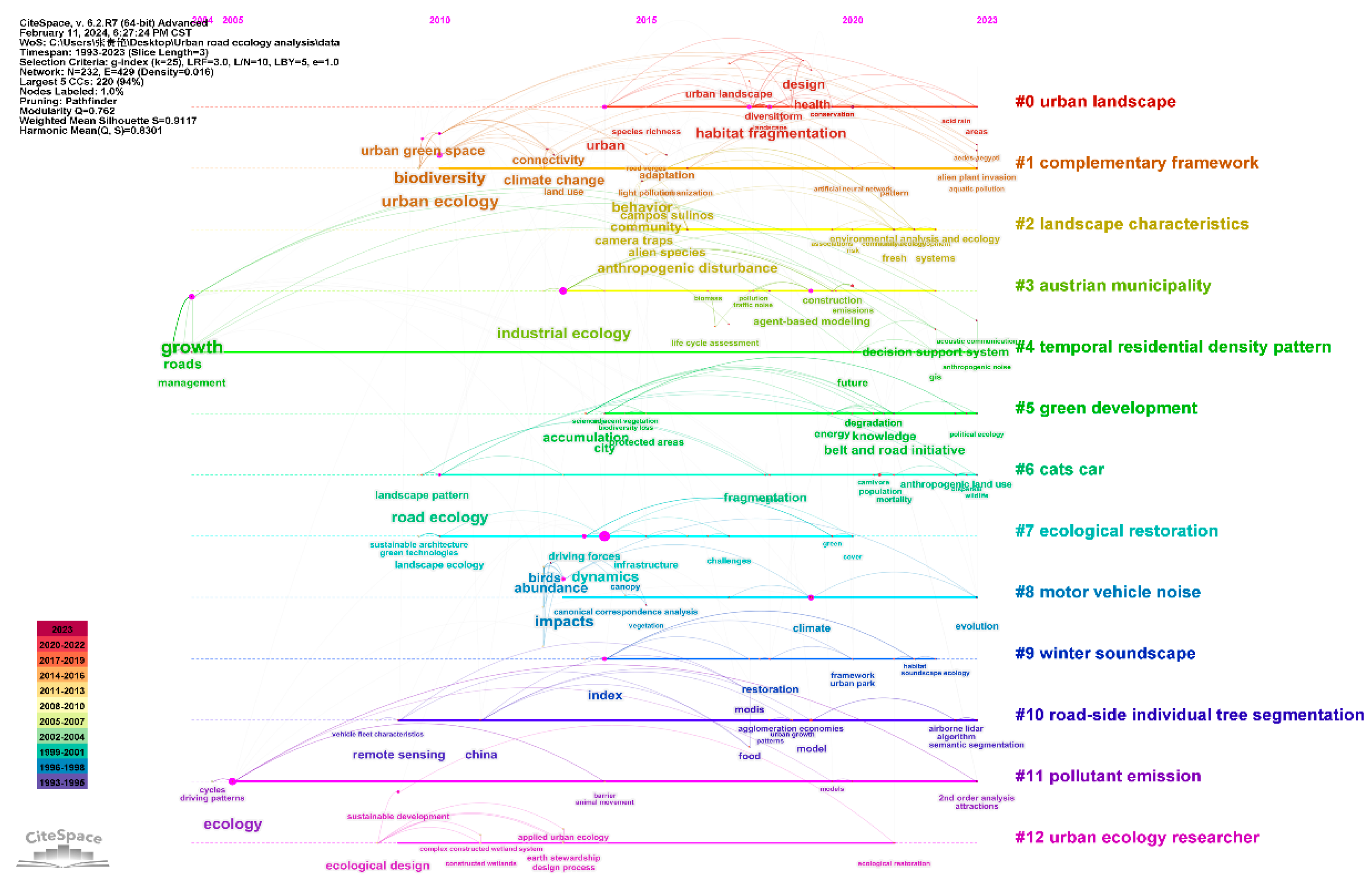
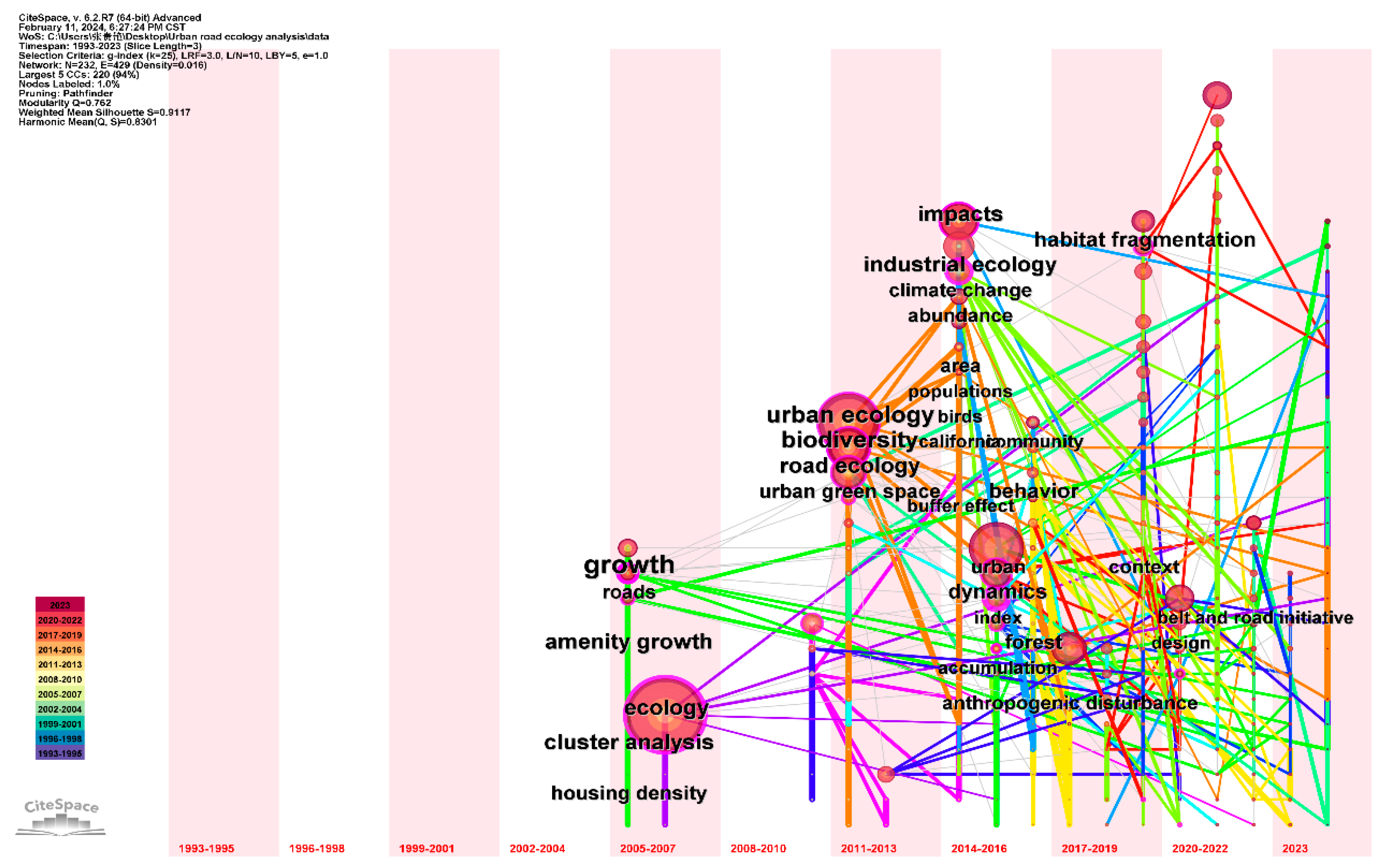

| Count | Centrality | Year | Institution |
|---|---|---|---|
| 15 | 0.02 | 2009 | Chinese Academy of Sciences |
| 6 | 0 | 2017 | University of Chinese Academy of Sciences |
| 5 | 0 | 2019 | Institute of Geographic Sciences and Natural Resources Research |
| 4 | 0 | 2014 | Arizona State University-Tempe |
| 4 | 0 | 2015 | California State University System |
| 4 | 0 | 2014 | Beijing Forestry University |
| 4 | 0 | 2020 | University of California System |
| 4 | 0 | 2014 | Arizona State University |
| 3 | 0 | 2016 | Centre National de la Recherche Scientifique (CNRS) |
| 3 | 0 | 2021 | University of Toronto |
| 3 | 0.01 | 2007 | China University of Mining and Technology |
| 3 | 0 | 2021 | Yale University |
| 3 | 0 | 2013 | Colorado State University |
| Cited Count | Centrality | Year | Title |
|---|---|---|---|
| 4 | 0 | 2017 | Effects of landscape composition and pattern on land surface temperature: An urban heat island study in the megacities of Southeast Asia (DOI: 10.1016/j.scitotenv.2016.10.195 [16]) |
| 3 | 0 | 2017 | Global socioeconomic material stocks rise 23-fold over the 20th century and require half of annual resource use (DOI: 10.1073/pnas.1613773114 [17]) |
| 3 | 0 | 2019 | Guidelines for the use of acoustic indices in environmental research (DOI: 10.1111/2041-210X.13254 [18]) |
| 3 | 0.02 | 2011 | Anthropogenic noise exposure in protected natural areas: estimating the scale of ecological consequences (DOI: 10.1007/s10980-011-9646-7 [19]) |
| 3 | 0 | 2017 | GIS-based Analysis of Vienna’s Material Stock in Buildings (DOI: 10.1111/jiec.12446 [20]) |
| 3 | 0.01 | 2008 | Evaluating the influence of road networks on landscape and regional ecological risk—A case study in Lancang River Valley of Southwest China (DOI: 10.1016/j.ecoleng.2008.07.006 [21]) |
| 3 | 0 | 2019 | Taking Stock of Built Environment Stock Studies: Progress and Prospects (DOI: 10.1021/acs.est.8b06652 [22]) |
| 3 | 0 | 2014 | A global strategy for road building (DOI: 10.1038/nature13717 [23]) |
| Time Cited | Centrality | Year | Journal Name |
|---|---|---|---|
| 94 | 0.35 | 2006 | LANDSCAPE AND URBAN PLANNING |
| 86 | 0.1 | 2010 | BIOLOGICAL CONSERVATION |
| 74 | 0.07 | 2005 | SCIENCE OF TOTAL ENVIRONMENT |
| 72 | 0.06 | 2010 | CONSERVATION BIOLOGY |
| 70 | 0.25 | 2006 | SCIENCE |
| 63 | 0.01 | 2013 | LANDSCAPE ECOLOGY |
| 62 | 0.01 | 2013 | PLOS ONE |
| 62 | 0.17 | 2013 | JOURNAL of ENVIRONMENTAL MANAGEMENT |
| 59 | 0.19 | 2006 | PROCEEDINGS OF THE NATIONAL ACADEMY OF SCIENCES OF THE UNITED STATES OF AMERICA |
| 56 | 0.05 | 2013 | JOURNAL OF APPLIED ECOLOGY |
| 46 | 0 | 2006 | NATURE |
| 44 | 0.02 | 2010 | BIODIVERS AND CONSERVATION |
| 43 | 0.04 | 2009 | ECOLOGICAL APPLICATION |
| 41 | 0.01 | 2013 | ANNUAL REVIEW OF ECOLOGY EVOLUTION AND SYSTEMATICS |
| 41 | 0 | 2018 | SUSTAINABILITY-BASEL |
| 40 | 0 | 2013 | TRENDS IN ECOLOGY AND EVOLUTION |
| 39 | 0.04 | 2013 | ECOLOGY |
| 39 | 0.03 | 2014 | ECOLOGICAL INDICATORS |
| 39 | 0.37 | 2010 | BIOSCIENCE |
| 39 | 0 | 2017 | ENVIRONMENTAL POLLUTION |
| Count | Centrality | Keyword |
|---|---|---|
| 39 | 0.24 | ecology |
| 31 | 0.18 | urban ecology |
| 28 | 0.1 | city |
| 21 | 0.14 | biodiversity |
| 19 | 0.13 | impacts |
| 18 | 0.01 | urbanization |
| 17 | 0.19 | road ecology |
| 16 | 0.02 | land use |
| 15 | 0.03 | model |
| 15 | 0 | ecosystem services |
| Cluster | Size | Silhouette | Year | Label (LLR) |
|---|---|---|---|---|
| 0 | 23 | 0.833 | 2018 | urban landscape; ecosystem service; landscape friction; accessible food resource; reported life satisfaction |
| 1 | 22 | 0.919 | 2015 | complementary framework; street tree; density diversity composition; potential case; urban parrot |
| 2 | 21 | 0.897 | 2018 | landscape characteristics; noise pollution; road density light; squirrel glider; urban encroachment |
| 3 | 19 | 0.982 | 2017 | Austrian municipality; material flow analysis study; transport sector; material stock development; noise footprint |
| 4 | 17 | 0.939 | 2009 | temporal residential density pattern; north central; analytical hierarchy process; urban sprawl susceptibility analysis; Sialkot city |
| 5 | 16 | 0.929 | 2018 | green development; green belt and road; political ecology perspective; extended infrastructure landscape; gateway project |
| 6 | 15 | 0.943 | 2017 | cats car; endangered felid; road network; urban landscape pattern; road centrality |
| 7 | 14 | 0.911 | 2015 | ecological restoration; urban green area; north-western Italy; integrated expansible; comprehensive analytical framework |
| 8 | 14 | 0.92 | 2014 | motor vehicle noise; novel landscape index; spatial road disturbance index; Brandenburg, Germany; conservation planning |
| 9 | 13 | 0.808 | 2019 | winter soundscape; different road type; variable effect; study design rationale; acoustic quality |
| 10 | 13 | 0.897 | 2016 | roadside individual tree segmentation; using metric learning; urban MLS point cloud; city-level comparison; global belt |
| 11 | 12 | 0.858 | 2014 | pollutant emission; de-France region; operating condition; use pressure; urban common |
| 12 | 8 | 0.955 | 2012 | urban ecology researcher; design process; urban wastewater treatment; innovative direction; new challenge |
Disclaimer/Publisher’s Note: The statements, opinions and data contained in all publications are solely those of the individual author(s) and contributor(s) and not of MDPI and/or the editor(s). MDPI and/or the editor(s) disclaim responsibility for any injury to people or property resulting from any ideas, methods, instructions or products referred to in the content. |
© 2024 by the authors. Licensee MDPI, Basel, Switzerland. This article is an open access article distributed under the terms and conditions of the Creative Commons Attribution (CC BY) license (https://creativecommons.org/licenses/by/4.0/).
Share and Cite
Yang, X.; Liu, Q. Research Foundation and Hotspot Analysis of Urban Road Ecology—A Bibliometric Study Based on CiteSpace. Sustainability 2024, 16, 5135. https://doi.org/10.3390/su16125135
Yang X, Liu Q. Research Foundation and Hotspot Analysis of Urban Road Ecology—A Bibliometric Study Based on CiteSpace. Sustainability. 2024; 16(12):5135. https://doi.org/10.3390/su16125135
Chicago/Turabian StyleYang, Xiaofan, and Qingfu Liu. 2024. "Research Foundation and Hotspot Analysis of Urban Road Ecology—A Bibliometric Study Based on CiteSpace" Sustainability 16, no. 12: 5135. https://doi.org/10.3390/su16125135
APA StyleYang, X., & Liu, Q. (2024). Research Foundation and Hotspot Analysis of Urban Road Ecology—A Bibliometric Study Based on CiteSpace. Sustainability, 16(12), 5135. https://doi.org/10.3390/su16125135






